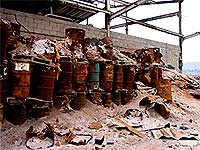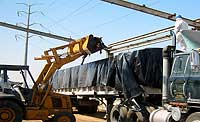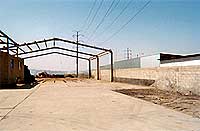Contact Pacific Southwest Waste Program
Pacific Southwest, Region 9
Serving: Arizona, California, Hawaii, Nevada, Pacific Islands, Tribal Nations
First Border 2012 Binational Site Stabilization Action

Waste drums at the Metales y Derivados site
Introduction
The US Environmental Protection Agency (EPA), SEMARNAT (Mexican Secretary for Environment & Natural Resources), and State of Baja California partnered to complete a cleanup demonstration at the Metales y Derivados (MyD) site, an abandoned secondary lead smelter and battery recycling facility in Tijuana, Mexico. The cleanup demonstration was performed to meet an institutional capacity building objective under the Border 2012 Plan (Goal 3 Reduce Land Contamination).
Cleanup objectives
 Metales y Derivados site
Metales y Derivados siteIn June 2004, as part of a Border 2012 coordinating event in Tijuana, Mexico, Administrator Leavitt of the US Environmental Protection Agency (EPA) and Minster Cardenas of the Mexican Ministry of Environment (SEMARNAT) met to affirm their commitment to protect their shared border. SEMARNAT and other government agencies also signed a declaration of cooperation and commitment of funding and institutional resources leading to the remediation of the MyD site.
Following the signing ceremony in Tijuana, EPA and SEMARNAT began the site stabilization action designed to remove wastes in drums and sacks posing the highest risks, consolidating wastes to a more confined area, and strengthening site access restrictions through fencing, signage and outreach. Health and safety practices to protect workers and the community were established as part of the cleanup plan.
Accomplishments
 Photo of Metales y Derivados site
Photo of Metales y Derivados siteIn June 2004, EPA and SEMARNAT contracted a specialized cleanup contractor. By September 2004, the contractor removed and transported 300 tons of hazardous waste to a facility in the United States. SEMARNAT also signed a declaration forming the work for the cleanup and risk reduction at the MyD site.
The work group is meeting regularly to address the four phases of the remediation process which include: risk reduction, site characterization and risk assessment, alternative analysis and selection, and implementation of selected remedy. Plans are in place to remove an additional 2000 tons in 2005 and to evaluate long-term cleanup remedies.
Additional Information
For more details on the cleanup refer to Metales Final Summary Report September 2004 PDF (114 pp, 10.6M, About PDF) or contact the Border 2012 California/Baja California Waste and Enforcement Task Force.
